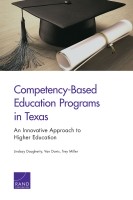| 来源类型 | Research Reports
|
| 规范类型 | 报告
|
| ISBN | 9780833091765
|
| 来源ID | RR-1239-1-CFAT
|
| Competency-Based Education Programs in Texas: An Innovative Approach to Higher Education |
| Lindsay Daugherty; Van L. Davis; Trey Miller
|
| 发表日期 | 2015
|
| 出版年 | 2015
|
| 页码 | 98
|
| 语种 | 英语
|
| 结论 |
Competency-Based Programs Have the Potential to Benefit Certain Students- Competency-based programs have the potential to increase the alignment between graduate skills and employer needs, as well as addressing degree-completion rates by offering new pathways to students.
- Program administrators for most of Texas's competency-based programs and a sample of students from one program report that the programs offer many benefits to students.
- Self-motivated students and students with prior education and work experience may be most likely to be successful in the nonstandard structure of competency-based programs.
- Competency-based programs offer the potential to obtain degrees and certificates at a significantly lower cost to student, particularly those with subscription-based tuition.
Development of Competency-Based Curriculum Still Has Some Challenges- Critics cite a number of concerns about competency-based programs, including the potential threat the programs provide to traditional programs and faculty jobs, concerns about the applied nature of the content and the impact this has on the ability to connect knowledge to theory, and the modularized structure and its inability to translate competencies across settings and to make connections across competencies.
- Some institutions in Texas and the literature faced challenges with implementation, including: (1) integration of the programs into existing administrative tools and processes, (2) restrictive oversight by the federal government and accreditors, (3) a need to ensure faculty buy-in and provide training, (4) a need to developing the content for the programs, (5) requirements for enhanced student support, (6) a need to develop stronger connections with employers, and (7) challenges with growing and sustaining the programs.
|
| 摘要 |
- Institutions should: (1) Invest time and resources to ensure an adequate understanding of competency-based programs and buy-in among key stakeholders (e.g., faculty, administrative staff); (2) leverage resources such as existing course materials, employer input, and industry standards to define competencies and develop resources; (3) target students who are most likely to be successful in the nonstandard structure of competency-based programs and inform students about the unique aspects of the program; (4) enhance student tracking and support systems; (5) examine attendance policies, financial aid procedures, academic policies, and business processes and practices to ensure they accommodate competency-based programs; and (6) continuously assess competency-based programs to ensure they are effective and sustainable and to ensure continuous improvement.
- State and federal policymakers should: (1) Consider institutional funding, financial aid, and academic policies and their implications for competency-based programs; and (2) encourage experimentation, assess the effectiveness of competency-based approaches, and facilitate the sharing of best practices.
|
| 主题 | Education Curriculum
; Educational Program Evaluation
; Postsecondary Education
; Teachers and Teaching
; Test-Based Promotion
; Texas
|
| URL | https://www.rand.org/pubs/research_reports/RR1239-1.html
|
| 来源智库 | RAND Corporation (United States)
|
| 资源类型 | 智库出版物
|
| 条目标识符 | http://119.78.100.153/handle/2XGU8XDN/107949
|
推荐引用方式
GB/T 7714 |
Lindsay Daugherty,Van L. Davis,Trey Miller. Competency-Based Education Programs in Texas: An Innovative Approach to Higher Education. 2015.
|
|
文件名:
|
x1495316200615.jpg
|
|
格式:
|
JPEG
|

|
文件名:
|
RAND_RR1239-1.pdf
|
|
格式:
|
Adobe PDF
|
除非特别说明,本系统中所有内容都受版权保护,并保留所有权利。